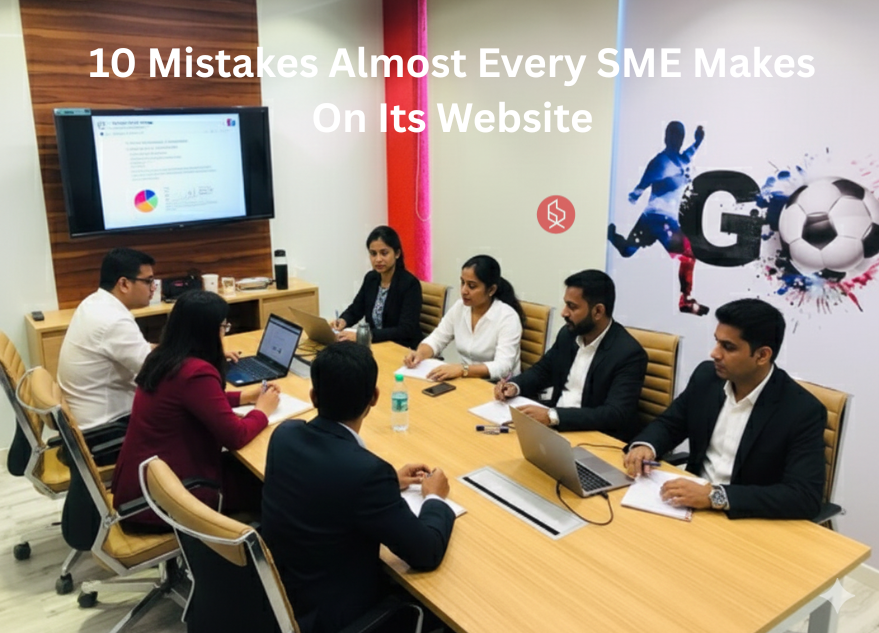The business landscape is shifting rapidly as AI gives small firms access to capabilities once limited to large enterprises. With AI adoption rising among SMEs, the resource and operational gaps between a five-person startup and a fifty-person company are quickly narrowing.
💡 Are you looking for Coworking space in Gurgaon, Noida or Delhi? We are just a call away. Call Now: 08999 828282
10 Ways AI Reduces the Gap Between Small and Medium Businesses
- Democratizing High-Level Customer Support
- Hyper-Personalized Marketing on a Budget
- Data Analytics for Strategic Decision Making
- Streamlining Human Resources and Recruitment
- Automating Operational Workflows
- Enhancing Financial Management and Forecasting
- Access to Global Markets through Localization
- Accelerating Product Development and R&D
- Leveling the Playing Field in Supply Chain Management
- The Agility Advantage
1. Democratizing High-Level Customer Support
Historically, the difference between small and medium enterprises was most visible in customer service; medium firms had dedicated support teams, while small businesses struggled to keep up. AI for SMEs has changed this dynamic entirely. With advanced AI chatbots and virtual assistants, a micro-business can now offer 24/7, multilingual support that rivals larger organizations. These tools handle inquiries instantly, process returns, and answer questions, creating the illusion of a massive support staff without the associated overhead costs.

2. Hyper-Personalized Marketing on a Budget
In the past, executing complex, data-driven marketing campaigns required a medium enterprise’s budget and a team of specialists. Today, generative AI allows small and medium enterprises to automate content creation, from blog posts to social media graphics. AI algorithms analyze customer behavior to deliver hyper-personalized email campaigns that increase conversion rates. This allows a solo entrepreneur to execute marketing strategies with the sophistication and frequency of a fully staffed marketing department, effectively blurring the lines of visibility.
3. Data Analytics for Strategic Decision Making
Data used to be the playground of the big players. Now, accessible AI analytics tools enable small businesses to process vast amounts of data to predict trends and customer preferences. This levels the playing field significantly. A small retailer can now forecast inventory needs with the same precision as a medium-sized competitor. By leveraging data-driven insights, small businesses can make strategic pivots quickly, mimicking the market intelligence that was once exclusive to larger entities.
Also Read: 10 Essential Tools for Small & Medium Size of Businesses
4. Streamlining Human Resources and Recruitment
Recruitment is time-consuming, often requiring a dedicated HR manager- a luxury usually found in medium enterprises. AI adoption in SMEs streamlines this by automating resume screening and candidate sourcing. AI tools can scan thousands of applications to identify top talent based on skills and cultural fit, removing bias and saving hours of manual work.
This allows small business owners to build high-quality teams efficiently, competing for the same talent pool as larger firms without a dedicated HR department.
5. Automating Operational Workflows
The operational capacity of small and medium enterprises often differs based on headcount. However, AI-driven automation tools (RPA) can handle repetitive administrative tasks like invoicing, data entry, and scheduling. By automating these workflows, a small team can achieve the output volume of a much larger organization.
This efficiency implies that the size of the workforce is no longer the primary dictator of operational throughput, allowing small firms to scale output without scaling costs.
6. Enhancing Financial Management and Forecasting
Financial stability and complex forecasting were traditionally easier for medium enterprises with CFOs and finance teams. AI for SMEs now offers innovative accounting software that automates bookkeeping, manages cash flow, and predicts financial health. These tools act as a “virtual CFO,” providing small business owners with high-level financial insights and risk assessments.
This capability ensures that small ventures can manage their finances with the rigor and foresight typically reserved for larger, more established companies.
7. Access to Global Markets through Localization
Expanding globally was a significant hurdle for small businesses due to language barriers and localization costs. The difference between small and medium enterprises regarding global reach is shrinking thanks to AI translation and localization tools.
These technologies allow small firms to instantly translate websites, marketing materials, and support documents into dozens of languages with high accuracy. A local artisan can now sell to an international audience as seamlessly as a medium-sized exporter.
8. Accelerating Product Development and R&D
Research and Development (R&D) typically requires deep pockets. However, AI tools assist in rapid prototyping, coding, and design, significantly shortening the product development lifecycle. Small tech startups can use AI code assistants to write and debug software faster than a medium-sized team working manually.
This acceleration allows small businesses to bring innovative products to market at a pace that disrupts larger competitors, proving that innovation is no longer a function of company size.
💡 Are you looking for Coworking space in Gurgaon, Noida or Delhi? We are just a call away. Call Now: 08999 828282
9. Leveling the Playing Field in Supply Chain Management
Managing a complex supply chain requires resources that small and medium enterprises often struggle to balance. AI-powered supply chain tools help small businesses predict delays, optimize routes, and dynamically manage inventory levels. By utilizing predictive algorithms, small firms can negotiate better rates and ensure product availability just as effectively as medium enterprises.
This efficiency reduces the cost per unit and improves reliability, removing a traditional advantage of larger-scale operations.
10. The Agility Advantage
While AI gives small businesses “big” capabilities, it also enhances their natural agility. Medium enterprises often have layers of approval that slow down AI adoption in SMEs. Small businesses can integrate new AI tools overnight. This combination of high-tech capability and low-bureaucracy speed allows small firms to outmaneuver medium-sized competitors.
They can adapt to market changes instantly, using AI to pivot strategies while larger organizations are still scheduling meetings to discuss them.
The rapid rise of artificial intelligence is fundamentally rewriting the rules of business hierarchy. By providing affordable access to enterprise-grade tools, AI is effectively erasing the resource-based disadvantages that once defined the difference between small and medium enterprises. For the aspiring entrepreneur, this means the barrier to entry is lower than ever; with the right AI tools, a small business can operate with the power, reach, and efficiency of a much larger organization.
Suppose you’re an entrepreneur or a growing business looking to adopt AI without complexity. In that case, The Office Pass (TOP) can support you with flexible, hassle-free workspace solutions that keep your team productive and collaboration-ready.
Contact The Office Pass (TOP): +91-89998-28282 to explore nearest coworking options and enhance your business operations with an innovative, professional work environment.
FREQUENTLY ASKED QUESTIONS (FAQS):
Question: What exactly is the difference between small and medium enterprises?
Answer: Traditionally, the difference between small and medium enterprises is defined by headcount and revenue. Small enterprises usually have fewer than 50 employees and lower revenue caps, while medium enterprises can have up to 250 employees (depending on the region) and higher revenue. However, AI is making these distinctions less relevant by allowing small teams to generate high revenue and output.
Question: Why is AI adoption in SMEs considered a game-changer?
Answer: AI adoption in SMEs is revolutionary because it decouples output from headcount. It allows small businesses to automate tasks that previously required human employees, such as customer support or data analysis. This means a small business can grow and scale its operations significantly without the heavy financial burden of hiring a massive workforce, increasing profitability and competitiveness.
Question: Is AI for SMEs too expensive for a beginner with a low budget?
Answer: Not at all. The market for AI for SMEs is highly competitive, leading to very affordable pricing models. Many powerful AI tools operate on a “freemium” or low-cost monthly subscription basis (SaaS). This accessibility ensures that even boot-strapped startups can access the same high-quality technology as established medium-sized companies without needing a large upfront capital investment.
Question: Will AI replace the need for human employees in small businesses?
Answer: AI is unlikely to replace humans entirely; instead, it augments human capabilities. It handles repetitive, mundane tasks, freeing up the business owner and employees to focus on creative, strategic, and relationship-building activities. In small and medium enterprises, this means the existing team becomes more productive and satisfied, focusing on high-value work rather than administrative drudgery.
Question: Do I need technical coding skills to use AI tools?
Answer: No, you do not need coding skills. Most modern AI tools designed for small and medium enterprises are built with “No-Code” or “Low-Code” interfaces. They feature drag-and-drop functionality and intuitive dashboards. Whether it is a chatbot, a marketing design tool, or an analytics platform, they are specifically designed for business owners, not software engineers.
Question: How does AI help in competing with medium-sized competitors?
Answer: AI helps you compete by increasing your speed and quality of service. For example, a medium enterprise might take days to analyze market data, whereas an AI tool can give a small business those insights in seconds. This allows you to react to trends faster. Additionally, AI ensures your customer service and marketing look just as professional as a larger firm’s.
Question: What are the risks of using AI for my small business?
Answer: The main risks involve data privacy and over-reliance. It is crucial to ensure that the AI tools you use comply with data protection regulations (like GDPR). Also, rely on AI for data and drafts, but always apply human judgment for final decisions. Small and medium enterprises must maintain a personal touch, which is often their unique selling proposition.
Question: Can AI really help with creative tasks like writing and design?
Answer: Yes, Generative AI is exceptionally good at creative tasks. It can draft blog posts, design logos, create social media captions, and even edit videos. For small and medium enterprises without a budget for creative agencies, these tools provide a “good enough” to “excellent” baseline that can be polished by the business owner, saving thousands of dollars in outsourcing fees.
Question: How do I choose the right AI tools for my business?
Answer: Start by identifying your biggest bottleneck. Is it answering emails? Creating content? Managing inventory? Look for AI for SMEs that specifically address that pain point. Read reviews, look for tools that offer free trials, and ensure they integrate well with the software you already use (like your email or accounting platform). Start small with one tool and expand.
Question: What is the future of small and medium enterprises with AI?
Answer: The future is a “hybrid” business model where the line between sizes blurs further. We will see “Micro-Multinationals”—very small teams using AI to operate globally. The success of small and medium enterprises will depend less on how many people they employ and more on how effectively they utilize AI to optimize their operations and serve their customers.









